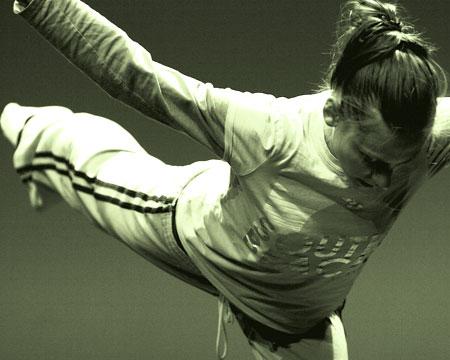endORPHIN: A Cyborg Manifesto

*endORPHIN*, creatd by the Plastic Orchid Factory and presented by this year's Dancing on the Edge Festival, takes us on a dark, apocalyptic journey into the subconscious of the 21st century. It shows human culture on the cusp of the cyborg era. The title endORPHIN – which ironically joins catastrophe and pleasure – suggests that this is a grim psychic reality where the only happiness is a terror-induced euphoria.
The performance proper started at 7pm, but at 6:30 there were six dancers onstage, positioned amidst white smoke and lit from high above with cold blue light. Dressed all in black rain gear, some clustered at centre stage, some around the perimeter. They appeared to be in a dream state – or perhaps they were sedated. They hung awkwardly, like empty suits of clothing on coat hangers. One by one, they would rise from the collapsed postures in which they found themselves and walk, with measured paces, to one of the other hooded, androgynous figures. Laying an arm or head against a companion, they would settle into a new resting pose. Stillness would reign, and then another figure would rise and reposition herself. In this way the dancers moved organically across the stage, seemingly without will or purpose, denuding one corner at a time of bodies, while filling another portion with black silhouettes.
Throughout this display, the theatre was flooded with the sound of voices, speaking in the cold robotic tones of a text-to-voice machine, in the manner of Stephen Hawking. A sample of the words gives a feel for their bleak, depressive chorus: “I get lost driving / I have trouble breathing / thinking about my day / any option to get out”. Another voice would cut in, as if describing the angst of a generation: “getting my taxes done on time / survive global warming / my skin gets itchy.” It is all spoken with a profound and abiding anxiety about banal events, like psychiatric patients itemizing their symptoms or the subjects of hypnosis speaking from within a nightmare.
At 7:00 the house lights went down and the voices fell silent. Moments later, they returned, more shrill than before. As their pitch increased, the voices were overtaken by a rhythmic sonic static that became the sound track of the evening. In the ensuing darkness, a lone dancer circled the stage, turning on LED lights one by one, so the dark was pierced by cold beams. When she finished, it became apparent that lights that had seemed fixed to the floor were actually attached to the bodies of other dancers.
endORPHIN is full of such surreal moments. Time and again, audience expectation is cleverly overturned. Dancers' bodies are made visible and real to the senses in surprising ways. They are not personalities, but are used as mechanisms, tools of the work itself.
endORPHIN is strange, aggressive, and powerful. Harsh mechanical music carries the audience relentlessly from scene to scene, and each progressive stage in the dance is as dark and fearsome as the last. The costumed dancers were alienating figures: their full-body attire seemed at once clinical and space age. As the pace of the movement and music intensified, they took on the air of martial artists: one memorable segment had pairs of dancers lit only by their LED lights, contorting around each other as if locked in mortal combat. The white lights on their bodies were like quills or metal spikes – futuristic weapons of attack. At the same time, it seemed as if the lights were gaping wounds, luminescent stigmata, that showed where their own bodies had been pierced.
Throughout, the music spanned extremes, from a deep grinding noise, like a furnace running at full tilt, to high insect chatter. Always, at the edge of hearing were the words, a litany of woes, fears, and other repressed emotions: “I'm sorry, sorry, I'm sorry, sorry” said one voice, over and over.
The floor was painted in three interlocking white squares, lit periodically from above, and dancers would enter, stripping off their suits, as if coming out of quarantine or passing though an air lock. They would dance, exposed to each other, with the intimacy of beings who rarely experience touch and are starved for direct human contact. Where earlier they grappled, rolled, and fell as opponents, here the dancers embraced with a poignant vulnerability. The climax of the work sees one dancer strip down to her underthings even as her companion engulfs herself in more and more black, synthetic clothing. It is an extreme juxtaposition, between the exposure of one and the armor of the other.
As a company, the Plastic Orchid Factory is dedicated to exploring “humanity's physiological and psychological relationship with its mental and physical environment.” endORPHIN reflects this preoccupation with the mechanization of human consciousness. The score seems to get under the skin of the figures onstage: it is as if we are hearing their telepathic communications and their most solitary emotions – as if these are one and the same. It suggests a future in which technology has made the human mind transparent and – because nothing is private, not even one’s innermost thoughts – where social control is total.
A conceptual tour de force, endORPHIN immerses viewers in a dystopian world where the human and the mechanical merge so totally that they are indistinguishable. It is a dark world, where individual emotions are subordinate to the mind of the machine.



